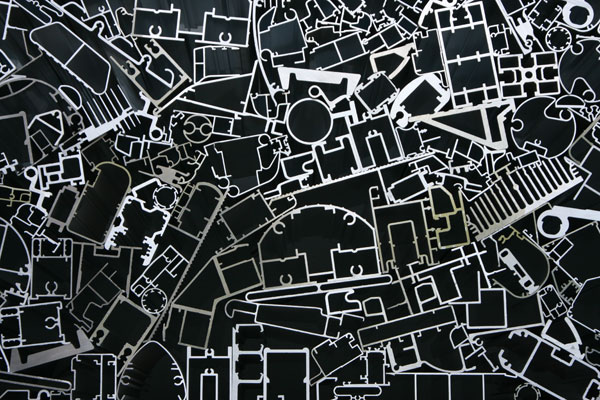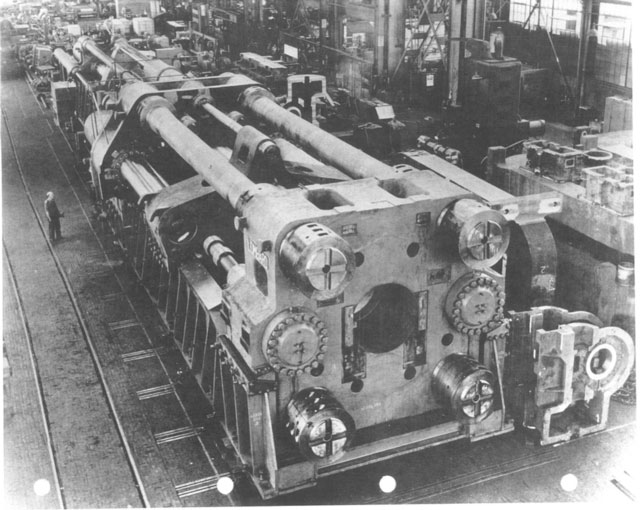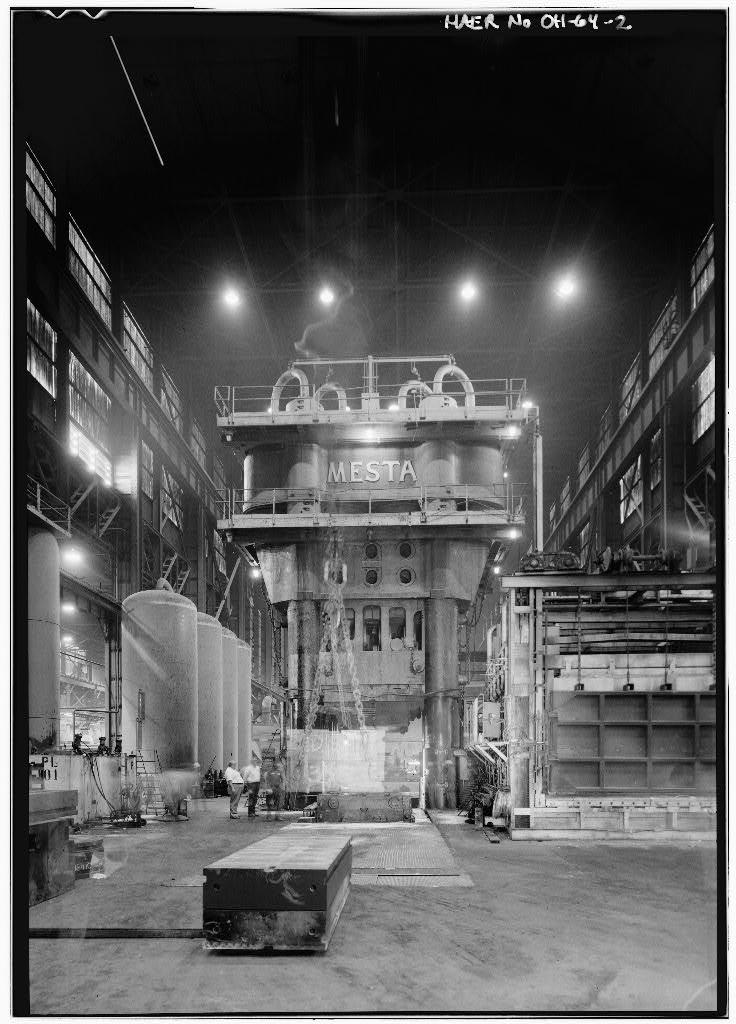Copied without permission Please read, this is amazing!
Germany, June 1945. The Nazi regime has been toppled; the war in Europe is over. But the Allied victory is largely the result of sheer overwhelming force, not technological superiority — and the victors know it. Most glaringly, while the Allies still rely on propeller-driven aircraft, the Luftwaffe has put three jets successfully into service.

A Messerschmitt Me 262, the first military jet to enter service. Brought to you by Krupp’s magnesium forging division. Photo: USAF
 A Boeing B-29, the first bomber with pressurized crew compartments. Brought to you by Rosie the Riveter. Source: USAF
A Boeing B-29, the first bomber with pressurized crew compartments. Brought to you by Rosie the Riveter. Source: USAF
The reasons for German air superiority were several, of course, but a key one was their mastery of light-metal forging. While the Allies were still bolting together their planes out of steel plate, a slow, labor-intensive process ripe for error and unsuited to design optimization, the Germans were stamping and squeezing out complex structural elements from magnesium and aluminum alloys.
Not surprisingly, after Germany surrendered, both the U.S. and the USSR sought to take control of its forging facilities.
The Soviets got the good stuff.
In so doing they got a head start on the Cold War race for supersonic air superiority. Unwittingly, they also set in motion a larger, and largely forgotten, industrial revolution that shaped the second half of the 20th century and will shape the 21st. This is the story of the birth of the Jet Age — but it’s anchored firmly to the ground.
The magnificent machine pictured above is a closed-die forging press, one of the biggest in the world. (For reference, check out the men standing at its foot, down there on the left.) It and nine other huge forges were built in 1950s by the U.S. government, in a long-forgotten endeavor called the Heavy Press Program. I wrote about the press and the program in the March Atlantic, and Maggie kindly invited me to write a bit more here, because — well, first of all, because just look at that thing. It stands nine stories tall (four of them are hidden under the floor), weighs 16 million pounds, exerts 50,000 tons of compressive force, and, like Vulcan’s own waffle iron, squeezes ingots of solid metal between its jaws until they flow like batter.
Here’s another picture for scale:

Each casting was loaded individually onto a specially built train car and carried from Pittsburgh to Cleveland. Photo: USAF Air Force Material Command
Those are just four of the 14 steel castings that make up the Fifty, as the press is known, and they aren’t even the biggest ones. Those would be the twin 250-ton upper stationary crossheads, shown in Figures 5 and 6 of this document— also a good source for more technical details about the press.
And here’s a before-and-after of the Fifty’s handiwork:

Press-forging minimizes waste metal compared to machining, and by realigning the metal’s internal crystalline structure along natural lines of stress, results in much stronger parts than casting would produce. Photos: Library of Congress
That’s a piece of titanium about 15 feet wide and a foot thick, in its raw state and after being forged in a single stroke between the Fifty’s hardened steel dies under 100 million pounds of pressure.
Though they were built nearly 60 years ago, the ten machines of the Heavy Press Program — four forging presses, the waffle irons, and six extrusion presses, basically giant caulking guns except the “caulk” is solid metal — are still among the most powerful ever made. Even more impressively, at least eight of the ten are still in use.

Extruded aluminum parts (not parts from Heavy Press Program machines). Photo courtesy Dalcio Metal
So, what do they do? Well, in strict terms, they make heavy components for aircraft, spacecraft, and power-generation facilities. That chunk of titanium, for example, became one of the bulkheads that anchor the engines, fuselage, and wings of an F-15. More familiarly, every time you fly on a Boeing or Airbus, you’re relying on parts made by the Heavy Press Program machines to keep you aloft—things like the wing spars, which connect the wings to the plane’s chassis.
But in broader terms, what the machines do is make the Jet Age possible. On a plane, a pound of weight saved is a pound of thrust gained—or a pound of lift, or a pound of cargo. A lighter plane also puts less stress on its chassis when it goes through maneuvers. Supersonic military jets are optimized for speed and strength. Subsonic passenger and cargo jets are optimized for fuel efficiency and load capacity. Without the ultra-strong, ultra-light components that only forging can produce, they’d all be pushing much smaller envelopes.
Dawn of the Military-Industrial Complex
Back to 1945 for moment. The Soviet acquisition of Germany’s biggest forges made it all but inevitable that the U.S. would build its own heavy presses—but it’s important to note that it did not make the Heavy Press Program inevitable. Private industry could have built its own machines. The government could have built them, too, and indeed early plans called for the military to construct a “pilot plant” and dole out chunks of time to the air industry to experiment on government-run machines. The idea that it was in the public’s interest to pay for the machines but cede their control to industry was a controversial one, and many leaders in Congress strongly resisted it as a dangerous blurring of private and civic concerns.
On the other hand, with millions of WWII servicemen and women being demobilized, mass unemployment was a threat, and shoring up the aerospace industry was an attractive way to stave it off and harness wartime technology to the peacetime economy. Cold War policy also encouraged massive defense spending, but (as ever) a secondary war was being waged by the military branches for funding, and heavy forging wasn’t of much use to the Army or Navy. It was a complex situation, and one that could have been resolved in several ways. But by 1949 it had been decided that the government would build a number of heavy forging machines and the factories to support them, and that these facilities would be leased to the great metals companies of the day on very generous terms. The Heavy Press Program had begun.
Nifty Fifty
The Fifty was installed at Alcoa’s Cleveland Works facility and began operations on May 5, 1955. A complementary 35,000-ton press was installed shortly after. I have their initial production list, and it reads like catalog of American military air power of the age: wing roots for the Republic F-105, wing spars for the Convair B-58, landing gear trunions for the Boeing B-52, bulkheads for the Lockheed C-130—in all, hundreds of items. From the start, the forges were busy machines.
The Heavy Press Program also supplied Wyman-Gordon of Grafton, Massachusetts, with a 50,000- and 35,000-ton pair of forging presses. Here’s their 50K, nicknamed Major (yep, the 35K is Minor), and again, note the man standing at its foot for scale:

The two 50,000-ton presses were of very different design — those interested can compare them here and here — but their dies were made to be interchangeable, so that production would not be disrupted if one of the machines broke down or was attacked during war. Photo: Library of Congress
To these four were added the six huge extrusion presses: a 12,000-tonner for Curtiss-Wright in Buffalo; twin 8,000-tonners for Kaiser in Halethorpe, Maryland; a 14,000-tonner for Alcoa in Davenport, Iowa; and an 8,000- and a 12,000-tonner for Harvey Aluminum in Torrance, California, just south of L.A. With stroke lengths of up to 92 feet, the extruders were used to produce long, hollow structures like aluminum missile bodies and wing struts in a single, seamless piece, saving time, weight, and material. Here’s the Harvey 12K, which went into service in August 1957:

Though it was nearly 300 feet long and weighed 8 million pounds, the maximum variance along the Harvey 12K’s chassis was just 0.004 inches. Source: USAF Materiel Command
This iron giant—which reminds me somehow of a steam train—is the one Heavy Press Program machine that definitely no longer exists: it was cut up for scrap in the 1990s. And I haven’t been able to confirm the fate of the 8,000-tonner at Harvey—though it may have been shipped to Korea or China.
As for the other eight machines, they’re still working. Curtiss-Wright’s extruder ultimately was bought by Precision Castparts and moved to Houston, and Kaiser’s pair was taken over by Alcoa, but their jobs haven’t changed. They make the things that make us fly, and they’ll be doing so for decades yet.
A Stamp on History
I see three main legacies of the Heavy Press Program.
First, of course, is the aeronautics industry as it now exists. We are accustomed to talking about the ways abstractions like “technology” or “Washington” have affected life the world over. But the machines of the Heavy Press Program are a concrete—well, an iron-and-steel—example of how industry and politics can collide with enormous yet unpredictable effect. The civilian air industry was an afterthought when the program was conceived, yet it is arguably the program’s signal achievement. Again, every Boeing and Airbus jet you’ve ever flown, every one that has carried mail or freight across the oceans, on was built around vital structural components made by these huge machines. Their impact on global society and commerce has been incalculably great. But every American military jet that has fired a gun or dropped a bomb in war was also built around Heavy Press parts—and thus the greatness of the program’s impact is morally blurred.

You can’t have this...

...without this.
Second is the military-industrial complex. I don’t believe it’s possible to place its origin in any single spot. But I am also not aware of any defense program since the HPP that was meaningfully opposed by Congress on the grounds that it threatened the functioning of American democracy. That a given project was “wasteful” or “bloated,” sure—but that’s just bookkeeping. The Heavy Press Program was in many ways the test case for the proper division between private and public interest, and it was decided in favor of what amounts to a mutual aid society between American industry, the American military, and Congress. The consequences are plain, and not often pretty.
Lastly is a legacy of absence. Today, America lacks the ability to make anything like the Heavy Press Program machines. The Fifty, to pick the one I’m most familiar with, was made by the Mesta Machine Company of West Homestead, PA, just outside of Pittsburgh. Mesta built the machines that built Steeltown — the furnaces, the blowers, the rolling mills and the forges. Mech-heads will want to check out this digitized Mesta brochure of 1919, a kind of Whole Earth Catalog for the iron industry. The less avid can just enjoy the picture below, from the same era. Then imagine what Mesta Machine could do by 1950, with three decades worth of further innovation under its belt.

Mesta could mold, cast, forge, machine and field-test huge components under one roof — literally — a full-service shop of the sort that no longer exists in the U.S. Photo: Carnegie Museum of Art.
The company went under in the mid-1980s. It is not unambiguously bad that it and the rest of American ultra-heavy manufacturing are gone. But it’s not unambiguously good, either. Conventional wisdom would say that the industry went to less-developed nations, freeing American resources for higher-tech pursuits. In fact, the only companies today capable of producing Heavy Press-size equipment are in the backwaters known as Germany and Japan, with companies in Russia, Korea, and China rapidly catching up and the UK actively rebuilding its top firm, Sheffield Forgemasters, through cheap government loans. Just last year four Japanese companies joined forces to build a new 50,000-ton press for the aerospace and power industries, and while I was working on this piece China Erzhong, a nationalized conglomerate, announced that it will build an 80,000-ton press — the biggest ever — to support its nascent aerospace industry.
Now is not the time for America to build new forges: eight really is enough. But the original heavy presses, which have lived far longer and spurred far more innovation than was ever imagined, set an example that I think might yet be followed. Big machines are the product of big visions, and they make big visions real. How about a Heavy Fusion Program?
















